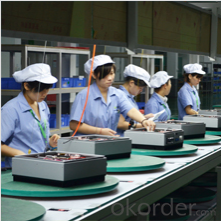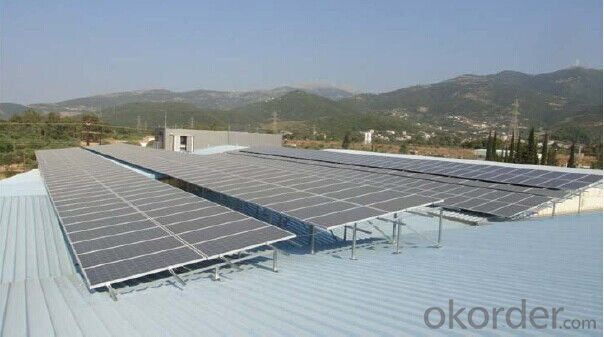Solar Inverter 2500MTL-3000MTL 2MPPT, Single Phase
- Loading Port:
- Shekou
- Payment Terms:
- TT or LC
- Min Order Qty:
- 10 pc
- Supply Capability:
- 100000 pc/month
OKorder Service Pledge
OKorder Financial Service
You Might Also Like
Solar inverter 2500MTL-3000MTL 2MPPT, single phase
Specifications
Maximum efficiency of 98% and wide input voltage range
Internal DC switch
Transformerless GT topology
Multi MPPT
Solar inverter General Descriptions
Leading-Edge Technology
> Maximum efficiency of 97.9 % and wide input voltage range
> Muti MPP controller
> Internal DC switch
> Transformerless H6 topology
> Compact design
> Muti MPP control
> MTL-String
> Bluetooth technology
> Easy installation
> Sound control
Europe /Australia ENS
> Simple national setting of line supply monitoring (ENS)
> Easy country configuration
> Muti-language display
> Currently available for Germany,France,UK,Austria,Switzerland,Italy and Spain
Solar inverter Communications
> RS485 /RS232/GPRS interfaces
> Computer monitoring software
Safety
> Full protection functions:DC reverse polarity, AC short-circuit protection, ground fault monitoring, grid monitoring, integrate all-pole sensitive, leakage current monitoring unit.
> Standards complied: SAA, CE/TUV, EN50178, VDE 0126-1-1,IEC 62109,RD 1663,G83,EN 61000-6-1,EN61000-6-2 ,EN61000-6-3,EN61000-6-4, DK5940, G83, RD1663, VDE-AR-N415, CEI 0-21


Technical Specifications
Model | 2500MTL | 3000MTL |
INPUT DATA | ||
Max. DC Voltage | 500V | 500V |
PV voltage range | 200V~500V | 200V~500V |
MPP Voltage Range | 200V~450V | 200V~450V |
Max. DC Power | 2700W | 3200W |
Max. Input Current | 10A/10A | 10A/10A |
Number of MPP Trackers/ | 2/1 | 2/1 |
Strings Per MPP Tracker | ||
OUTPUT DATA | ||
Nominal AC Output | 2500W | 3000W |
Max.Output Current | 12.5A | 15A |
Grid Voltage Range | 180~280V | 180~280V |
Rated Grid Frequency | 50Hz/60Hz | 50Hz/60Hz |
Output Current THD | < 3% | < 3% |
AC connection | Single phase | Single phase |
SYSTEM | ||
Max. Efficiency | 97.50% | 97.50% |
Euro. Efficiency | 97.00% | 97.40% |
MPPT efficiency | 99.50% | 99.50% |
Protection Degree | IP65(outdoor) | IP65(outdoor) |
Operating Temperature | -25~+60°C | -25~+60°C |
Cooling Method | No fan | No fan |
Display | LCD | LCD |
Standard Comm. Interfaces | RS485/RS232 | RS485/RS232 |
Optional Comm. Interfaces | GPRS/blue tooth | GPRS/blue tooth |
MECHANICAL DATA | ||
Dimensions(WxHxD) | 360/510/188mm | 360/510/188mm |
Net Weight | 15.6kg | 15.6kg |
Solar inverter FAQ
1. Have any design tool and how to use it?
Shine Design is the system design software just for inverters, It can conduct installers to figure out panel numbers for a system, panel numbers for each string, and which inverter model is suitable for the system. Moreover, it can print a design report after input all necessary parameters, can calculate DC/AC wire wastage, annual generation, etc.
2. Does the inverter have monitoring solutions for residential system?
For small rating system, we have wired two monitoring solution (ShineNet via RS232 or RS485). (a) Local wireless monitoring solution (ShineVision via RF module communication) (b) Global wireless monitoring solution (WIFI module via WIFI network)
3. Do you have free solution for monitoring?
ShineNet is an inverter monitoring software run in Windows XP, Windows Vista, Windows 7 operating system. It can monitor inverter via RS232 (or RS232 convert to USB cable) and RS485 wire connection. Customers can purchase the cable locally to get the inverter monitored, it is simple.
- Q:Can a solar inverter be used with solar-powered air conditioning systems?
- Yes, a solar inverter can be used with solar-powered air conditioning systems. The solar inverter is responsible for converting the direct current (DC) generated by the solar panels into alternating current (AC) that can be used to power various electrical appliances, including air conditioning units. By connecting the solar inverter to the solar panels and the air conditioning system, the generated solar energy can be efficiently utilized to power the AC system.
- Q:What is the maximum number of solar panels that a solar inverter can support?
- The maximum number of solar panels that a solar inverter can support depends on the capacity and specifications of the specific inverter model. There is no universal limit, as different inverters have different capabilities, but typically, a solar inverter can support anywhere from a few panels to several hundred panels. It is important to consult the manufacturer's guidelines and technical specifications to determine the maximum number of panels that a particular solar inverter can handle.
- Q:Can a solar inverter be used in a three-phase power system?
- Yes, a solar inverter can be used in a three-phase power system. In fact, three-phase solar inverters are commonly used in commercial and industrial applications where three-phase power is utilized. These inverters convert the DC power generated by solar panels into AC power that can be seamlessly integrated into the three-phase power grid.
- Q:How does a solar inverter handle grid islanding conditions?
- A solar inverter handles grid islanding conditions by continuously monitoring the grid voltage and frequency. In the event of a grid outage or disturbance, the solar inverter detects the change and disconnects from the grid to ensure the safety of utility workers. It then enters islanding mode, wherein it generates electricity from the solar panels and supplies it to the local loads. This prevents backfeeding and maintains a stable power supply within the isolated system.
- Q:Can a solar inverter be used with solar trackers?
- Yes, a solar inverter can be used with solar trackers. Solar trackers are designed to follow the sun's movement throughout the day, maximizing the solar panel's exposure to sunlight. The solar inverter converts the DC (direct current) power generated by the solar panels into AC (alternating current) power that can be used in homes or businesses. The inverter can be connected to the solar tracker system to ensure efficient and effective utilization of the solar energy harvested by the panels.
- Q:Are there any limitations on the number of solar panels that can be connected to a single inverter?
- Yes, there are limitations on the number of solar panels that can be connected to a single inverter. The maximum number of panels that can be connected depends on various factors such as the power rating of the inverter, the voltage and current ratings of the panels, and the configuration of the system. In general, the inverter should be able to handle the combined power output of all the connected solar panels. If the panels generate more power than the inverter can handle, it may lead to system inefficiencies, reduced performance, or even damage to the inverter. Additionally, the voltage and current ratings of the panels should be within the acceptable range of the inverter. If the panels have a higher voltage or current rating than what the inverter can safely handle, it may result in overloading or malfunctioning of the inverter. Furthermore, the configuration of the solar panels also plays a role in determining the limitations. Panels can be connected in series or parallel, and each configuration has its own requirements and limitations. The inverter needs to be compatible with the specific configuration being used. To ensure proper functioning and optimal performance, it is recommended to consult the manufacturer's guidelines and specifications for both the solar panels and the inverter. These guidelines will provide information on the maximum number of panels that can be connected to a single inverter and any other specific limitations or requirements that need to be considered.
- Q:What is the lifespan of the capacitors in a solar inverter?
- The lifespan of capacitors in a solar inverter can vary depending on various factors, such as the quality of the components, operating conditions, and maintenance. Generally, high-quality capacitors can have a lifespan of around 10 to 15 years. However, it is important to regularly monitor and maintain the inverter to ensure optimal performance and longevity of the capacitors.
- Q:Can a solar inverter be used with different types of power factor correction devices?
- Yes, a solar inverter can be used with different types of power factor correction devices. Solar inverters are designed to convert DC power generated by solar panels into AC power for use in electrical systems. Power factor correction devices are used to improve the power factor of the electrical system, which is the ratio of real power to apparent power. By using an appropriate power factor correction device, the solar inverter can ensure efficient and optimized operation of the electrical system, regardless of the type of power factor correction device being used.
- Q:Can a solar inverter be used in regions with high levels of dust or debris?
- Yes, solar inverters can be used in regions with high levels of dust or debris. However, it is important to regularly clean and maintain the solar panels and inverters to ensure optimal performance and prevent any potential damage caused by the accumulation of dust or debris.
- Q:Can a solar inverter be used with solar-powered water purification systems?
- Yes, a solar inverter can be used with solar-powered water purification systems. A solar inverter is responsible for converting the direct current (DC) produced by solar panels into alternating current (AC) for powering electrical devices. In the case of solar-powered water purification systems, the solar panels generate electricity, which is then converted by the inverter to power the system's pumps, filters, and other components required for water purification.
1. Manufacturer Overview |
|
|---|---|
| Location | |
| Year Established | |
| Annual Output Value | |
| Main Markets | |
| Company Certifications | |
2. Manufacturer Certificates |
|
|---|---|
| a) Certification Name | |
| Range | |
| Reference | |
| Validity Period | |
3. Manufacturer Capability |
|
|---|---|
| a)Trade Capacity | |
| Nearest Port | |
| Export Percentage | |
| No.of Employees in Trade Department | |
| Language Spoken: | |
| b)Factory Information | |
| Factory Size: | |
| No. of Production Lines | |
| Contract Manufacturing | |
| Product Price Range | |
Send your message to us
Solar Inverter 2500MTL-3000MTL 2MPPT, Single Phase
- Loading Port:
- Shekou
- Payment Terms:
- TT or LC
- Min Order Qty:
- 10 pc
- Supply Capability:
- 100000 pc/month
OKorder Service Pledge
OKorder Financial Service
Similar products
New products
Hot products
Hot Searches
Related keywords































